Arm's New Cortex-A78 and Cortex-X1 Microarchitectures: An Efficiency and Performance Divergence
by Andrei Frumusanu on May 26, 2020 9:00 AM EST- Posted in
- SoCs
- CPUs
- Arm
- Smartphones
- Mobile
- GPUs
- Cortex
- Cortex A78
- Cortex X1
- Mali G78
Performance & Power Projections: Best of Both Worlds
We quickly looked at some projected figures at the start of the article, but now that we've had a chance to dig through the new CPUs, let's more precisely define the expected performance, power and area gains that the new Cortex-A78 and X1 cores are supposed to achieve.
Starting off with the Cortex-A78, the first comparison figures here are meant to represent the generational improvements the A78 would achieve in a target 2021 system on a TSMC N5 node. So the figures here contain both the microarchitectural gains as well as the expected process node improvements.
In terms of performance, at an ISO-power target of 1W for a core, Arm says that an A78 implementation would bring with it a 20% increase in performance, which is a healthy upgrade. A 2.6GHz A77 here on N7 here grossly matches the MediaTek Dimensity 1000(+), and the 1W power figure also roughly matches the power I’ve measured on that SoC.
Meanwhile at an ISO-performance comparison, the A78 would be able to halve the power and energy consumption compared to a 2.3GHz A77 on N7. This comparison is likely aimed at various mid-core implementations out there in the market, it is a bit of an arbitrary comparison but Arm also showcases some better figures we’ll go over in just a bit.
When actually looking at an ISO-process node comparison with a similar core configuration (essentially what Arm expects to be most commonly implemented), we’re seeing the A78 improve performance by roughly 7% over a Cortex-A77, all while reducing power by 4% and reducing area by 4%. It’s again important to note that while these figures sound maybe a little timid, Arm’s projected figures here do showcase an A78 with a lower-bounds configuration such as only 32KB L1D and L1I caches. I think the best way to interpret these numbers is to assume that this would be an implementation vendors would use to implement as their middle performance cores, leaving the higher perf targets for the X1.
Interestingly, Arm here for the first time ever published a whole performance/power curve of a microarchitecture, comparing the A77 to the A78. We see the higher cost at higher operating frequencies and the quadratic increase in power with increased voltage that is required to reach those higher frequencies (P = f * V²).
At the same peak performance point the A77 was able to achieve, the new A78 would use up 36% less power. At a more intermediate performance level (I think they might be using the process’ nominal voltage point here), this power reduction would be 30%. Finally, at the same power level, the A78 can increase performance by 7%.
Moving onto the Cortex-X1, the generational performance improvements here are a lot more impressive, and we’re seeing an increase of +30% in terms of peak performance at the same frequencies versus the A77. This comparison would actually be a maximally configured X1 versus a maximally configured A77. It's to be noted that we never saw a 3GHz A77 by vendors, meaning the real-world performance boost would actually be even bigger than this (I’m actually expecting vendors to finally hit that 3GHz target this time around, on 5nm, fingers crossed).
The 30% IPC improvements versus the A77 cover both integer and floating-point suites of SPEC2006, which is extremely impressive. Arm also showcased Stream bandwidth improvements as well as Octane performance boosts, although I don’t find these to be quite as relevant, although they do serve as pointers of what to expect of the microarchitectures in such workloads.
Arm was relatively vague on the power and area efficiency of the X1, quoting that they aren’t quite as public with these figures for these “custom” parts as they are with public roadmap designs such as the Cortex-A78, but I was able to figure out a few rough metrics. In terms of area, on a similar process, we should expect an X1 cores to be roughly 1.5x the size of an A78 – including the difference between maximized L1 and L2 caches. Power should also be roughly in that ballpark figure.
If vendors are able to actually do a good implementation and there aren't any bad surprises with the upcoming 5nm processes, we should be seeing something similar to these projections:
Again, as a big note – these figures are largely my own projections based on the various data-points that Arm has presented. This can end up differently in actual products, but in the past our predictions of the A76 and A77 ended up extremely close to the actual silicon, if not even pessimistically worse than what the real figures ended up at.
This generation, I do expect vendors to actually hit the 3GHz target for the Cortex-X1, as I have heard this being one of the goals the vendors are aiming to achieve for next year’s SoCs. I’m not too sure how many vendors will be doing for this for the Cortex-A78, which will more likely end up at lower clock speeds and implemented with a greater focus on power efficiency and area.
The Cortex-A78 would generally end up with the same power usage as current generation A77 products such as the Snapdragon 865 – with the vendors possibly using the process gains to get the last hundred MHz required to reach the 3GHz mark. The performance projection here is largely based on Arm’s +7% performance boost as well as a small clock boost. It would be a respectable upgrade, but nothing too earth-shattering in terms of generational updates.
The performance bump of an X1 system would be extremely competitive here, essentially being 37% faster than a Snapdragon 865 SoC today. That’s a huge generational bump and would put Arm very much in distance of Apple’s A13 cores, although in reality its competition would be the upcoming A14.
What’s really shocking here is how close Arm would be getting to Intel and AMD’s current best desktop systems in terms of performance. If both incumbent x86 vendors weren’t already worried about Arm’s yearly rate of improvement over the last few generations, they should outright panic at these figures if they actually materialize – and I do expect them to materialize.
The Cortex-X1 here is projected to use 1.5x the power of an A78. This might end up slightly lower but I’m being overly cautious here and prefer to be on the more pessimistic side. Here’s the real kicker though: the X1 could very well use up to 2x the power of a Cortex-A77/A78 and it would still be able to compete with Apple’s cores in terms of energy efficiency – the core’s increased performance largely makes up for its increased power draw, meaning its energy efficiency at the projected power would roughly only be 23% worse than an A78, and only 11-14% worse than say a current generation Snapdragon 865. Arm has such a big leeway in power efficiency at the moment that I just don’t see any scenario where the X1 would end up disappointing.
For years we’ve wanted Arm to finally go for no-compromise performance, and the Cortex-X1 is seemingly exactly that. That’s really exciting.


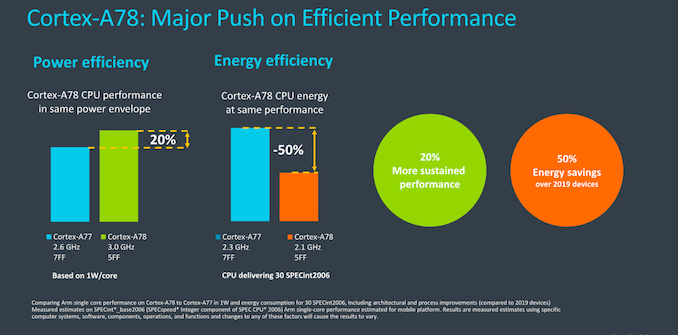
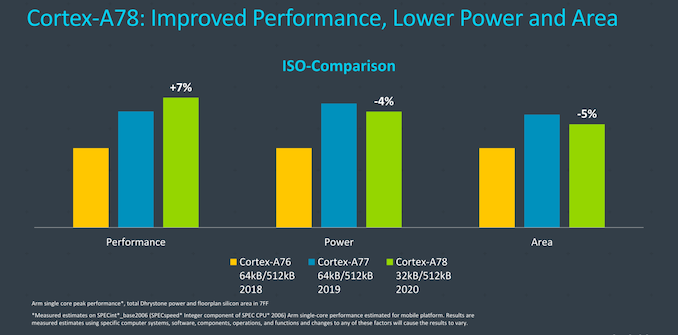

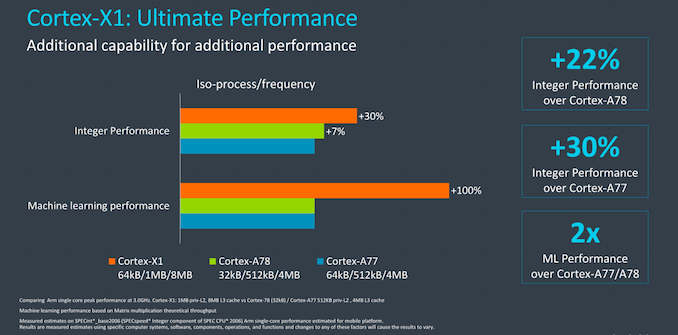
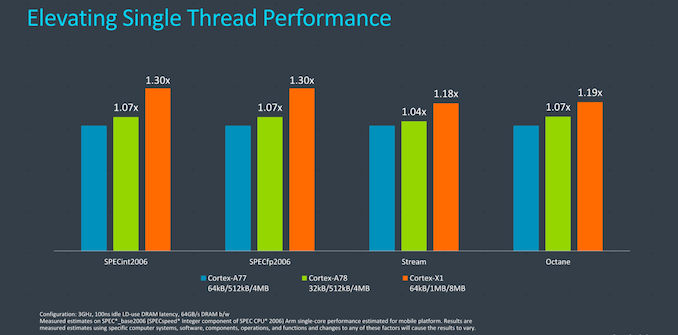
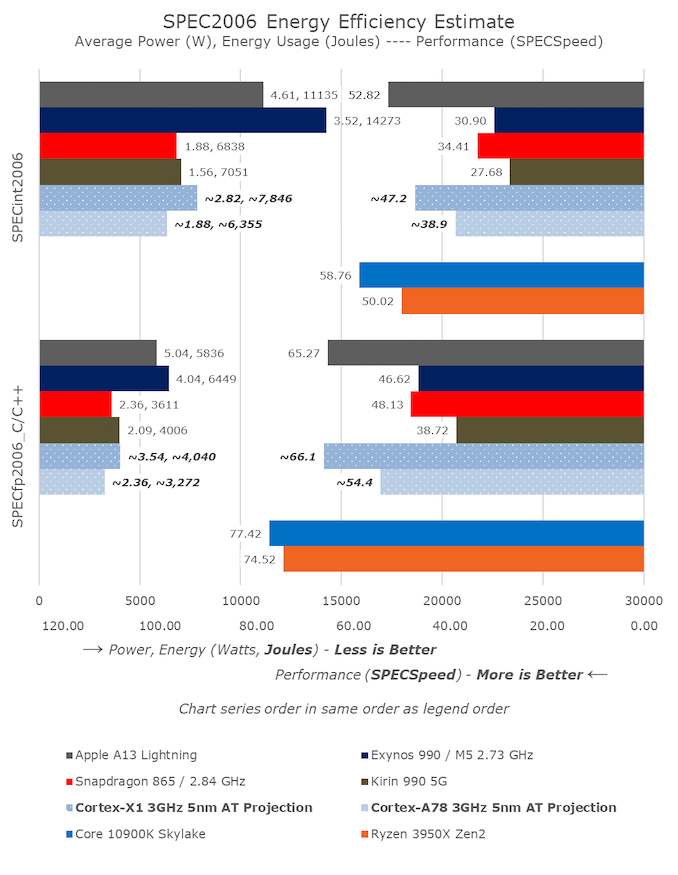








192 Comments
View All Comments
tkSteveFOX - Wednesday, May 27, 2020 - link
Would be great if we get a 1 x X1 + 3xA78 and 4xA55 with 4MB L3 shared between the big cores.Or just 2 x X1 and 6xA55 cores with 8MB L3 cache for the X1 cores (would be interesting to see the efficiency here compared to the above).
5nm gives a lot of headroom and even using 1x3GHz A77 and 3x2.7 GHz A77 is possible under this node.
ReverendDC - Wednesday, May 27, 2020 - link
I'm excited to see what comes of this for Windows on ARM. I know that's are some that will find it pointless, but there are millions of office workers and IT pros that support them that would find an all-day, cheaply replaceable, Office chewing, LTE/5G always connected device to be quite useful...For years Intel has tried to make an all-day system, and finally straight gave up! Yes, Windows is "heavier" on system calls, but then again, Linux can be as well. Seems to have shoehorned in nicely after 4+ years of trial and error (and Law and Order, but...) with Android. While I wouldn't buy a Surface Pro X, it does do 80% of what to expect from a full day Win10 x86 system. That's progress. Let's see if this makes more!
serendip - Wednesday, May 27, 2020 - link
The X1 belongs in a flagship ARM Windows device like the next Surface Pro X. The current model has a Qualcomm SQ1 and it already performs at 8th gen Core i5 levels, with half the power consumption when running ARM code. An X1-based SoC could offer top tier i7 performance at half the power and hopefully a lower price. Competition is good to keep Intel honest.ballsystemlord - Thursday, May 28, 2020 - link
@Andrei You have a technical error:"...all while reducing power by 4% and reducing area by 4%"
In the picture area reduction is 5, not 4 percent.
"...all while reducing power by 4% and reducing area by 5%"
anonomouse - Saturday, May 30, 2020 - link
So with two tiers of big cores now, and presumably a new small core and supposedly a new middle-ish core to span the ever-increasing gap between big and little... does this mean that in a couple of years Android phones will have to deal with scheduling across 4 different types of cores? bigger.big.middle.little?fozia - Saturday, June 6, 2020 - link
I agree. But it's not an achievement to be slower than a 1-year old chip This creates the problem that you cannot hyper-focus on any one area of the PPA triangle without making compromises in the other two.vladpetric - Friday, June 26, 2020 - link
Peak performance is not performance."Peak" is really just a value you're guaranteed to never exceed ...
mi1400 - Tuesday, October 6, 2020 - link
https://images.anandtech.com/doci/15813/A78-X1-cro...Why the yellow and orrange starting points/dots have drift in them. The Spec Performance axiz doesnt mandate them to let one start ahead of other. And if this mandate is applied/removed conjoining both stating points the difference of performance will be so similar that both lines will seem overlapping... infact curves between 2nd and 3rd dots of A77/A78 will make A78 even slower. Curves between 3rd and 4th dots of A77/A78 will give A78 some benefit but again curve between 4th and and 5th dots will make A77 = A78.
What do u say!?! Thanks!
ChrisGX - Monday, October 12, 2020 - link
A lot of people are saying that with Cortex-X1 ARM is bringing the fight to Apple’s powerhouse CPUs, i.e. the potent custom ARM processors that Apple develops for consumer computing products.Actually, that isn't exactly what is happening. I had a close look at the performance data (using ARM's own projections) and it looks like it will take until the Makalu generation before a successor to the X1 (very nearly) catches up to the A14 on outright (integer) performance. For some time, Apple has had a 2.5 year lead in the performance stakes over ARM and no change is on the cards in that regard. Cortex X1, contrary to ARM's public remarks, continues the existing strategy of winning on energy efficiency not seeking performance gains at any cost. As a matter of fact, the energy efficiency of the X1 isn't too bad as a starting point. And, when modestly clocked A78 cores are also in the mix energy efficiency improves greatly. With the next generation of SoCs based on A78 and X1 licensed ARM cores manufacturers will have the opportunity to either sharply reduce power consumption or add new and advanced processing capabilities without raising power budgets. And, that can be achieved while offering a good (single threaded) performance boost of 33% (or more) over existing A77 based processors.
When its comes to outright execution speed it seems that ARM is pushing harder on floating point performance than other areas. In that area ARM could conceivably reach performance parity with Apple's SoCs sooner rather than later.
Salman Ahmed - Tuesday, April 6, 2021 - link
Can Cortex A75 and Cortex A76 be pared together?